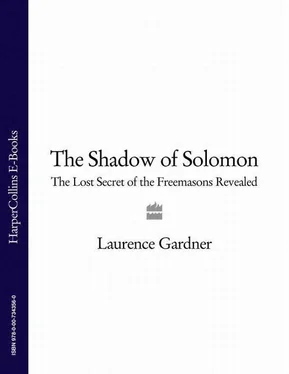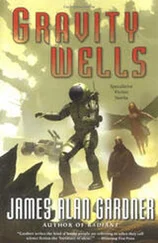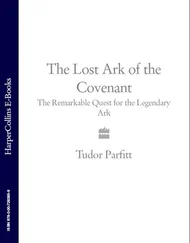There are many allegorical glyphs and symbols used in Freemasonry; some are well known, others are not. But of all these, the most potent is among the least familiar to outsiders—a point within a circle  . As we shall see, the whole original purpose of Freemasonry rests with the definitive meaning of this device, which dates back to ancient times. We shall also discover that a time-hon-oured aspect of the Craft known as the Royal Arch Chapter holds the ultimate key to Freemasonry. Although the Chapter is optional to Brethren, it is within this particular ritual (as distinct from the three primary degrees) that the light of masonic heritage truly shines—yet the all-important Royal Arch was totally ignored by the Grand Lodge establishment for 96 years from its foundation. Many masons have wondered why the biblical Ark of the Covenant appears at the crest of the Arms of the United Grand Lodge of England, when it is not an item of significance in the Craft degrees. But clearly—as our investigation will reveal—it was once of the utmost significance, just as were the enigmatic Philosophers’ Stone, and the Golden Calf that Moses burnt to a powder in Sinai.
. As we shall see, the whole original purpose of Freemasonry rests with the definitive meaning of this device, which dates back to ancient times. We shall also discover that a time-hon-oured aspect of the Craft known as the Royal Arch Chapter holds the ultimate key to Freemasonry. Although the Chapter is optional to Brethren, it is within this particular ritual (as distinct from the three primary degrees) that the light of masonic heritage truly shines—yet the all-important Royal Arch was totally ignored by the Grand Lodge establishment for 96 years from its foundation. Many masons have wondered why the biblical Ark of the Covenant appears at the crest of the Arms of the United Grand Lodge of England, when it is not an item of significance in the Craft degrees. But clearly—as our investigation will reveal—it was once of the utmost significance, just as were the enigmatic Philosophers’ Stone, and the Golden Calf that Moses burnt to a powder in Sinai.
Our task is to undertake precisely what formalized Freemasonry sought to achieve when it was established back in 1717. It is, in essence, the quest for a philosophical treasure, and for a lost Mason’s Word which is the code to unlocking that treasure. The difference between our quest and that undertaken by the Fraternity itself is that we are not constrained by in-house preconceptions. Hence, our approach will succeed where earlier efforts have failed. Many of the time-honoured mysteries are, in fact, perfectly traceable, and emerge as being far more dramatically exciting than might be imagined.
Laurence Gardner
Exeter, March 2005.
PART I
1 Ancient Secrets
A Magical Heritage
Stories of the biblical King Solomon reside at the heart of modern Freemasonry. They relate especially to the building of his lavish Temple in Jerusalem, where the Ark of the Covenant was housed in the Holy of Holies. Famed for his extraordinary wealth and wisdom, this son of King David from around 950 BC presents an Old Testament enigma. He is greatly revered in Judaic lore, but also criticized for having a number of wives and for allowing many deities to be worshipped within his realm. Notable in the Solomon accounts are his relationships with the King of Tyre and the Queen of Sheba, each of whom supplied him with valuable gifts and a vast quantity of gold to enrich his kingdom of Judah ( see page 285).
Outside the Bible, Jewish tradition holds that Solomon was a practitioner of divine technology, with a magic ring and a gem that could cut through stone with silent precision. And it was said that he kept the Ark mysteriously suspended above the ground. In such respects, King Solomon was regarded well beyond his era as a master magician, and he became a much revered figure in Renaissance Europe. As we shall see, the geometry of his Temple was considered to represent sacred perfection; the secret of his stone-cutting and his ability with levitation became subjects of scientific quest, and his passionate interest in gold was a source of constant fascination.
In figurative terms, Solomon holds the key to unlock the secrets of modern Freemasonry, but before the institution was formalized in 1717, the historical connection to his legacy rested with the Poor Knights of Christ and the Temple of Solomon. Commonly known as the Knights Templars, this elite fraternity of Western European knights—a military legation with a monastic structure—was founded in the early 1100s as an ambassadorial fraternity after the First Crusade. The question arises, therefore: Did the masonic movement take its lead from the Templars? If so, how does a modern-day charitable fraternity reconcile with a medieval Order of warrior monks? Or did Freemasonry evolve from stonemasons’ guilds, as is generally portrayed? Perhaps it began with the mystery schools of ancient Egypt, with which there are recognizable similarities. Whatever the case, the same question applies: How does the present institution equate with any of these?
The Bible’s Old and New Testaments have been used for centuries as scriptures which underpin the Jewish and Christian faiths, but that is not how they were originally conceived; neither were the Testaments written as cohesive volumes. They consist of a series of individual works written by different people at different times, eventually brought together with common purpose. The books embody aspects of history which, in the Old Testament, encompass lengthy spans of time, but they have a greater value than history alone in that the inherent stories often relate to truly extraordinary events. The fact that modern Freemasonry (which is neither a faith nor a religion) should focus on certain of these events after such a period of time is intriguing in itself, but it has been an evolutionary process which has brought a variety of past disciplines within the wrap of a single ideal.
In researching pre-18th century Freemasonry in its various guises, it becomes clear that its constituent parts were more romantically exciting as individual subjects than they have become beneath a masonic umbrella which veils them with allegory. Most notable is the science and nature of alchemy—the art of material transposition, which is most commonly associated with gold—along with the manipulation of light waves and, not least in the equation, the techniques of levitation. As recorded in texts from Mesopotamia, Egypt and other countries from the 3rd millennium BC, there is abounding evidence that the technological capabilities of ancient civilizations were far superior to anything credited to them by latter-day educational establishments. The study of such documents not only confirms a good deal of biblical scripture, but sheds a whole new light on the history and origins of Freemasonry. It is time, therefore, to put aside conventional dogma and preconceptions, and to look afresh at the archival material that supports the masonic ideal. To help us in our quest, we should first look at Freemasonry as it exists today and, in particular, at what its formative Constitution has to say about the masonic secrets themselves.
The Riddle of the Lost Archive
Freemasonry is described by the United Grand Lodge of England as ‘a peculiar system of morality, veiled in allegory and illustrated by symbols’. It is associated with the funding of schools, hospitals and care centres. But, worthy as these activities might be, it appears that they were introduced to give meaning and purpose to a brotherhood which apparently had no access to records of the tradition which it endeavoured to emulate. When the Presbyterian mason Rev James Anderson compiled and published The Constitutions of the Free-Masons in 1723, he wrote:
Very little has come down to us that testifies the English masonic tradition before the latter 17th century. Many of the Fraternity’s records of Charles II’s and former reigns were lost in the next and at the Revolution of 1688; and many of them were too hastily burnt in our time for fear of making discoveries.
Anderson’s reference to the ‘English masonic tradition’ is important because it reflects a commonly held view that Freemasonry is English by design. In loose terms, this is fair comment since the first Grand Lodge (as against separately run independent lodges) was instituted in London in 1717. Just six years after this, Anderson commented on the fraternity’s records of a previous generation—an archive that had seemingly been lost. Were those records English, or were they perhaps Scottish, given that King Charles II Stuart (whom he mentions) was of the royal line of Scotland? The Knights Templars certainly had been prevalent in Scotland after being banished by the Pope from England and Europe in 1307, but the 12th-century origin of the Templars was a matter of French historical record before it was Scottish.
Читать дальше

 . As we shall see, the whole original purpose of Freemasonry rests with the definitive meaning of this device, which dates back to ancient times. We shall also discover that a time-hon-oured aspect of the Craft known as the Royal Arch Chapter holds the ultimate key to Freemasonry. Although the Chapter is optional to Brethren, it is within this particular ritual (as distinct from the three primary degrees) that the light of masonic heritage truly shines—yet the all-important Royal Arch was totally ignored by the Grand Lodge establishment for 96 years from its foundation. Many masons have wondered why the biblical Ark of the Covenant appears at the crest of the Arms of the United Grand Lodge of England, when it is not an item of significance in the Craft degrees. But clearly—as our investigation will reveal—it was once of the utmost significance, just as were the enigmatic Philosophers’ Stone, and the Golden Calf that Moses burnt to a powder in Sinai.
. As we shall see, the whole original purpose of Freemasonry rests with the definitive meaning of this device, which dates back to ancient times. We shall also discover that a time-hon-oured aspect of the Craft known as the Royal Arch Chapter holds the ultimate key to Freemasonry. Although the Chapter is optional to Brethren, it is within this particular ritual (as distinct from the three primary degrees) that the light of masonic heritage truly shines—yet the all-important Royal Arch was totally ignored by the Grand Lodge establishment for 96 years from its foundation. Many masons have wondered why the biblical Ark of the Covenant appears at the crest of the Arms of the United Grand Lodge of England, when it is not an item of significance in the Craft degrees. But clearly—as our investigation will reveal—it was once of the utmost significance, just as were the enigmatic Philosophers’ Stone, and the Golden Calf that Moses burnt to a powder in Sinai.










